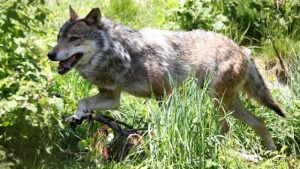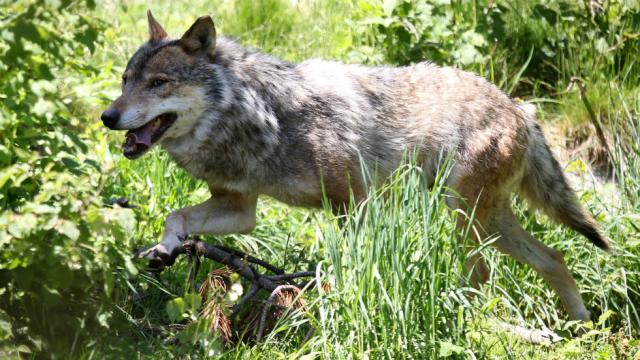OUR WOLVES DESERVE A WOLF CONSERVATION MANAGEMENT PLAN BASED ON SCIENCE! KILLING WOLVES IS NOT A SOLUTION.
CALL GOVERNOR BROWN at 503-378-4582 TO UPDATE THE PLAN. ~A

Here is a great article by Erik Movar about what is really happening in Oregon.
As wolves are recolonizing the wide-open spaces of the West, they are running into a buzzsaw of political meddling at the hands of a ranching industry that yearns for the glory days of its forebears, who killed wolves to the brink of extinction generations ago.
In eastern Oregon, public controversy has erupted over the kill order issued this month by state wildlife officials for two members of the Harl Butte wolf pack in northeastern Oregon, the latest in a long and bloody history of political deals, deception and feuding over the ranching industry’s perceived “right” to kill native wildlife to ease its mind and further its profits.
As the gray wolf began its comeback in the inland Northwest, however, the situation quickly got out of hand. In 2005, Oregon adopted a state wolf plan. As usual in collaborative processes, commercial interests got their wish list — including the ability to have wolves killed if they could be linked to predation on domestic livestock. And so the state adopted a plan allowing an endangered species to be killed, in violation of Oregon state law.
And so, when the first wolves made it into Oregon through natural dispersal, the first pack — the Imnaha Pack — was subjected to multiple killings at the request of ranchers. In 2011, the dwindling pack was targeted with a kill order for two of the four remaining pack members, including one of the alpha pair.
Cascadia Wildlands, and Oregon environmental group, immediately filed for a court injunction to block the kill order. Nick Cady, an attorney with Cascadia Wildlands, succeed in having a judge block the Imnaha pack’s kill order the same day.
Thanks to these protections, one of the Imnaha Pack’s offspring, OR-7, established the first-ever breeding pack of wolves in southwestern Oregon, and later became grandsire to California’s new Lassen Pack. Wolves are listed under that state’s Endangered Species Act, and enjoy strong protections because California state law forbids the killing of wolves for the benefit of agricultural operations (or any other reason).
Of course, this scientifically questionable wolf de-listing was immediately challenged in court; the lawsuit is currently pending.
When outgoing Oregon Gov. John Kitzhaber left under a cloud of ethics allegations in 2015, Secretary of State Kate Brown became governor. She inherited Kitzhaber’s staff on natural resource issues, who happened to be quite cozy with the eastern Oregon livestock industry. In the midst of the chaos, the cattlemens’ associations pushed through a bill — House Bill 4040 — declaring an “emergency” and blocking the courts from ruling on state endangered species decisions involving wolves.
Brown, newly anointed and perhaps swayed by pro-ranching staff members, signed the bill into law in a move that drew heavy criticism.
Stymied in their efforts to kill endangered wolves, the Oregon ultimately decided in 2015 to remove the legal protections by de-listing wolves under the state Endangered Species Act. The statewide wolf population at the time was only 81 animals, with only four breeding pairs, statewide numbers were tenuous. So the Oregon Department of Fish and Wildlife concocted a model criticized by scientists for unrealistically assuming the rapid population growth of early wolf expansion would be sustained over time, instead of factoring in known population density limits that halt wolf population growth when all available wolf territories become occupied. In science, this is called “cooking the books.”
Meanwhile, the political circus has careened onward. Earlier this year, a study funded by the Oregon Beef Association found that wolves were giving their cattle post-traumatic stress disorder (PTSD). (Conveniently for the ranchers and their concern for livestock mental health, no stress testing was conducted at slaughterhouses.) The industry then tried court filings asserting Oregon wolves aren’t native wildlife.
This summer, the Oregon Department of Fish and Wildlife issued new kill order at a rancher’s request, this time for two members of the Harl Butte Pack, an offshoot of the original Imnaha Pack. This was soon followed by an additional kill order targeting the Meacham Pack at the request of a Umatilla County rancher.
Wolves are rare, highly valued by the public and of incalculable ecological value as a key part of natural systems. Cattle, by contrast, are a dime a dozen— not to mention an invasive species non-native to North America — bred specifically to be killed for their meat. Oregon alone has more than a million of them. If wolves kill a cow or calf before we get a chance to do the same, they deserve a tip of the cap as a professional courtesy to a fellow predator, not a death sentence.
But there is a bigger lesson to be drawn from the dirty politics of Oregon’s state-sponsored wildlife killings. Killing native wildlife shows everyone involved in an unflattering light: Bureaucrats look incompetent (or worse, corrupt), state biologists look like they don’t understand basic science, apologists for predator killing look like sellouts and ranchers look like bloodthirsty killers.
In politics, perception is reality. It is long past time for Oregon to take a look in the mirror, check its reality, and come up with better solutions that afford wildlife — and specifically wolves — their place in the natural order of the state. Where is Brown on solving the state’s problematic approach to wolves? Endangered species recovery based on science and coexistence rather than politics makes everyone look better, and more importantly, it actually works.
Erik Molvar is executive director of Western Watersheds Project, a nonprofit environmental conservation group dedicated to protecting and restoring western watersheds and wildlife. He is also a published wildlife biologist.

Comments
You are killing wolves for for your own gain. It it needs to be stopped. You are hurting our environment and taking away Mother Nature. These Wolves have every right to live
STOP MURDERING OUR WOLVES!!! ALL SPECIES ARE ESSENTIAL FOR A HEALTHY ECOSYSTEM!!!